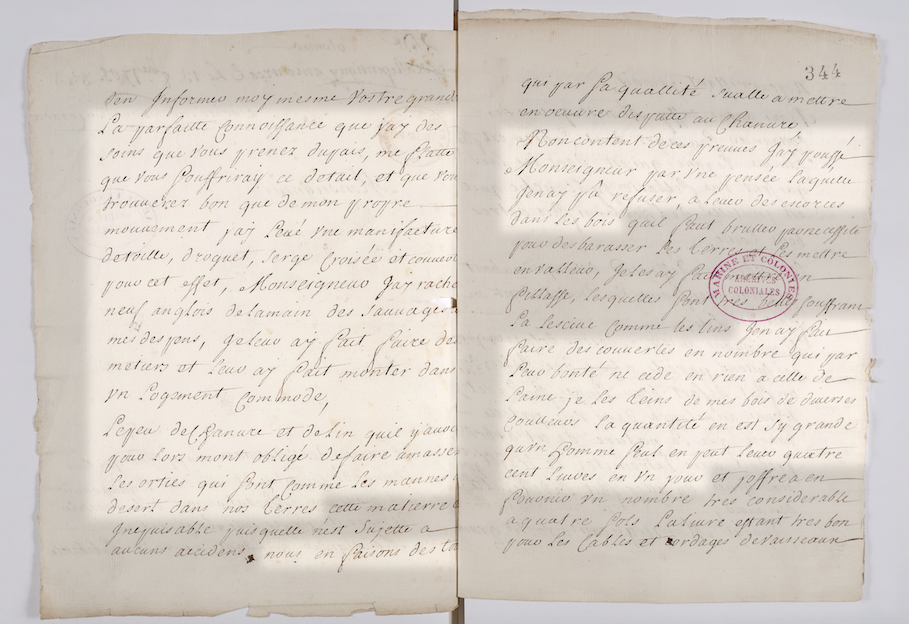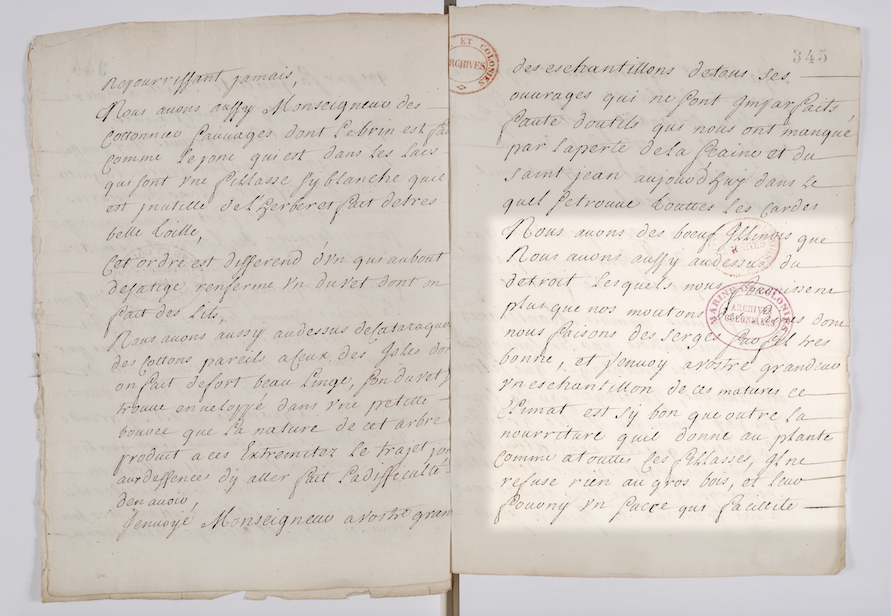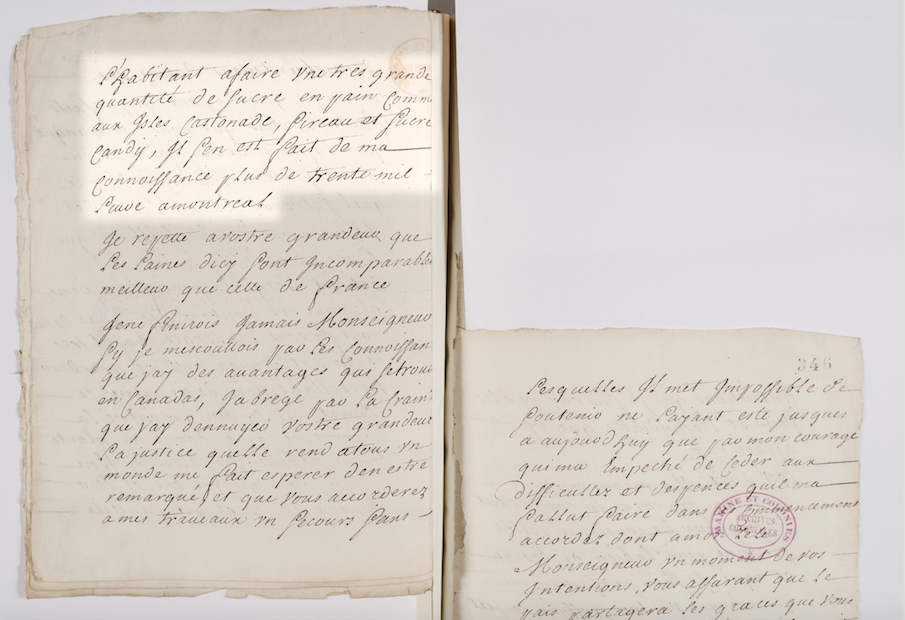Letter from Agathe de Saint-Père de Legardeur de Repentigny to the Minister of Marine and Colonies
Document
Image
Video
Audio
 Activities
Activities
LOOK
Listen to or read the excerpt from Agathe de Saint-Père’s letter. What are its key messages?
THINK
What does the document tell us about Agathe de Saint-Père’s social status? Do you have evidence to support your answer?
Extension: Do you think Agathe de Saint-Père’s role in the colony is representative of all women in New France? Explain your answer using historical evidence.
THINK
How does this document (a letter) differ from other historical documents such as legislation, diary entries, newspaper articles, written speeches, etc? What are some benefits and drawbacks in using each type of document as historical evidence?
THINK
To understand people from the past, we need to understand their historical perspective. In this instance, we would ask: Who wrote this letter? What might have motivated them to write it? Who was the intended recipient, and is that person significant?
DO
Listen to or read the excerpt from Agathe de Saint-Père’s letter. Are there any parts that you don’t understand? If so, list any questions they prompt, and do some research to find the answers. This is called corroborating evidence.
Details
 Materials
Materials - Paper
Transcript
Knowing full well your interest in this country, I am flattered that you wish to hear the details of my business endeavours and that you will be pleased to read about how I have single-handedly established a factory making linen, drugget, twill serge, and blankets. For this, I ransomed nine English men from their Indian captors at my own expense. I had looms built for them and have put them up in suitable quarters. The shortage of hemp and flax has forced me to gather nettles, which abound in our land. From it, we make a canvas. Not satisfied with these results, I was impelled, my Lord, by a thought I couldn’t ignore: to collect bark in the woods. From it, I have made numerous blankets that are as good as wool. I dye them using woods of various colours. The bark is so plentiful that a single man can gather 400 lbs of it in a day. We also have Illinois cattle that we find north of Detroit, and which yield more wool than our sheep. From this wool, we make strong serge thread. I enclose for you, my Lord, a sample of this material.
The climate here is so good that it nourishes not only textile crops but also large trees. It imbues these trees with a sugar which the habitants collect to make sugar loaf, as in the Caribbean Islands. Brown sugar, syrup and sugar candy. To my knowledge, they make more than 30,000 lbs of it around Montréal.
Historical Context
Choose one of the three levels below to match your needs.
- This letter was written in 1705 by Agathe de Saint-Père de Repentigny, an entrepreneur in New France, to the Minister of Marine and Colonies of France.
- In the letter, de Saint-Père describes her textile business, the materials she and her employees use and the collection of maple sap.
Agathe de Saint-Père de Repentigny was an entrepreneur in 18th-century New France. With the support of her husband, she built a successful textile mill and produced maple syrup.
This letter was written by de Saint-Père to the Minister of Marine and Colonies of France in 1705. In it she describes her textile business and the different materials that she and her employees use. She also describes making blankets using materials found locally. Although she does not mention them, it’s likely that she was inspired by local Indigenous peoples.
De Saint-Père also notes that the climate in New France “imbues … trees with sugar which the habitants collect.” She is referring to the maple sap used to make maple syrup and other sweeteners.
Agathe de Saint-Père de Repentigny was an entrepreneur in 18th-century New France. With the support of her husband, she built a successful textile mill and produced maple syrup.
This letter was written by de Saint-Père to the Minister of Marine and Colonies of France in 1705. In it she describes her textile business and the different materials that she and her employees use. The region had a shortage of flax and hemp, and Agathe describes using materials found locally, such as nettles, bark, milkweed and bison wool, to make blankets. Although she does not mention them in her letter, it’s likely that she was inspired by local Indigenous peoples, who used these same materials.
De Saint-Père also notes that the climate in New France “imbues … trees with sugar which the habitants collect.” She is referring to the maple sap used to make maple syrup and other sweeteners. This practice was also learned from the Indigenous communities in the area.
- This letter was written in 1705 by Agathe de Saint-Père de Repentigny, an entrepreneur in New France, to the Minister of Marine and Colonies of France.
- In the letter, de Saint-Père describes her textile business, the materials she and her employees use and the collection of maple sap.
Agathe de Saint-Père de Repentigny was an entrepreneur in 18th-century New France. With the support of her husband, she built a successful textile mill and produced maple syrup.
This letter was written by de Saint-Père to the Minister of Marine and Colonies of France in 1705. In it she describes her textile business and the different materials that she and her employees use. She also describes making blankets using materials found locally. Although she does not mention them, it’s likely that she was inspired by local Indigenous peoples.
De Saint-Père also notes that the climate in New France “imbues … trees with sugar which the habitants collect.” She is referring to the maple sap used to make maple syrup and other sweeteners.
Agathe de Saint-Père de Repentigny was an entrepreneur in 18th-century New France. With the support of her husband, she built a successful textile mill and produced maple syrup.
This letter was written by de Saint-Père to the Minister of Marine and Colonies of France in 1705. In it she describes her textile business and the different materials that she and her employees use. The region had a shortage of flax and hemp, and Agathe describes using materials found locally, such as nettles, bark, milkweed and bison wool, to make blankets. Although she does not mention them in her letter, it’s likely that she was inspired by local Indigenous peoples, who used these same materials.
De Saint-Père also notes that the climate in New France “imbues … trees with sugar which the habitants collect.” She is referring to the maple sap used to make maple syrup and other sweeteners. This practice was also learned from the Indigenous communities in the area.
Summary
- This letter was written in 1705 by Agathe de Saint-Père de Repentigny, an entrepreneur in New France, to the Minister of Marine and Colonies of France.
- In the letter, de Saint-Père describes her textile business, the materials she and her employees use and the collection of maple sap.
Essential
Agathe de Saint-Père de Repentigny was an entrepreneur in 18th-century New France. With the support of her husband, she built a successful textile mill and produced maple syrup.
This letter was written by de Saint-Père to the Minister of Marine and Colonies of France in 1705. In it she describes her textile business and the different materials that she and her employees use. She also describes making blankets using materials found locally. Although she does not mention them, it’s likely that she was inspired by local Indigenous peoples.
De Saint-Père also notes that the climate in New France “imbues … trees with sugar which the habitants collect.” She is referring to the maple sap used to make maple syrup and other sweeteners.
In-Depth
Agathe de Saint-Père de Repentigny was an entrepreneur in 18th-century New France. With the support of her husband, she built a successful textile mill and produced maple syrup.
This letter was written by de Saint-Père to the Minister of Marine and Colonies of France in 1705. In it she describes her textile business and the different materials that she and her employees use. The region had a shortage of flax and hemp, and Agathe describes using materials found locally, such as nettles, bark, milkweed and bison wool, to make blankets. Although she does not mention them in her letter, it’s likely that she was inspired by local Indigenous peoples, who used these same materials.
De Saint-Père also notes that the climate in New France “imbues … trees with sugar which the habitants collect.” She is referring to the maple sap used to make maple syrup and other sweeteners. This practice was also learned from the Indigenous communities in the area.




